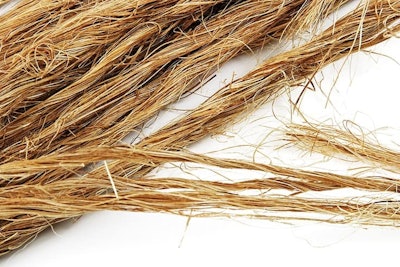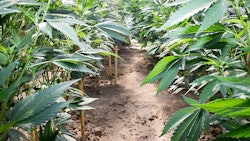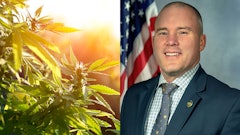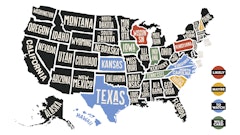
When people hear that Mark Sunderland—chief innovation officer of Hemp Black and Thomas Jefferson University’s vice president of innovation and technology—is tinkering with hemp textiles, they assume he’s designing T-shirts, Sunderland says. But his research goes far beyond soft, short-sleeved shirts, and for good reason: Hemp just can’t compete with cotton.
In order to create hemp T-shirts—or towels, curtains and underwear, for that matter—innovators would compete against materials like cotton that have permeated society and stores for decades. And “that would be a very poor direction to go in,” Sunderland tells Cannabis Business Times. “Looking at applications or research that involve trying to take the fiber off the [hemp] stalk and processing it into a yarn to make a material became very daunting. The commercial industry partners are not there yet and that kind of technology would … not be used for a very long time.”
So, four years ago, when Sunderland joined Jefferson’s hemp project at the Lambert Center for the Study of Medicinal Cannabis and Hemp—a center that researches the applications of hemp across many industries—he thought outside of the box, or, in this case, outside of yarn.
The researchers took the hurd—the whey portion of the hemp plant—and processed it down into nanoparticles, creating a “a building block for new fibers and new yarns going forward, so that these materials can be brought into the existing commercial supply chain,” Sunderland explains.
In 2016, Australian philanthropist Barry Lambert gave $3 million to the university to create the Lambert Center for the Study of Medicinal Cannabis and Hemp. Last April, Lambert gifted another $2 million to the university to set up the Lambert Innovation Fund within Jefferson’s Innovation Pillar, which will advance novel uses for hemp in medical and other industries.
Today, the university continues to research hemp, but what started at the campus has also grown into Hemp Black, a hemp technology company and subsidiary of Ecofibre that operates separately from but also maintains a partnership with the university, explains Michael Savarie, Hemp Black’s sustainability Enterprise Catalyst and graduate of Jefferson.
Hemp Black has developed and patented multiple hemp technologies, including its Hemp Black Original, a “carbon infused high-performance fiber” that is made “by pyrolyzing hemp bio mass and grinding the char down to make fiber master batches,” and can aid in moisture management, temperature regulation, anti-static, and conductivity, among other things; and Hemp Black Nano, a “fabric film spun from various polymer solutions with full spectrum hemp oil extract,” and that bonds well with other materials, “giving the ability to be more water resistant or increase wick-ability,” according to its website. It’s these materials that will make high-performance clothing.
Savarie says there’s increasing demand for high-performance textiles that work well but don’t take a toll on the environment—or our bodies. For example, some athletic wear uses silver to neutralize odor. “Silver on the body isn't the most healthy thing,” Savarie points out. “It also washes off us and goes into the ecosystem, which has led to changes within the marine life.”
He continues, “We're able to offer the assemblers better products—natural products that are able to neutralize the odor. That's huge. And more and more consumers are saying they want to know what's in their products—they want to know what’s harmful to them and the environment, and they want something that is natural. We're able to provide it.”
In fact, consumer demand is the “main thing” driving Hemp Black’s research, Savarie says. “If we don't have consumer demand or market demand, we don't have a business,” he explains. “We can create the world's best product, but if nobody asks for it, then we don't really have anything.”
Take, for example, wearable technology. Savarie says there’s a demand for clothing that helps us stay on top of our health, tracking our steps, recording our heart rates, and more. “There's a space that needs to be filled,” he says, “and currently that space is being filled with clunky wires going into fabric.” But Hemp Black has technology that could eliminate clunky, uncomfortable wires.
“Some of our technologies have showed results would being conductive,” he says, “so you'd be able to eliminate any wires and just adapt our technologies and get the exact same benefits that you from traditional wires and all that using just our technology—which is a natural material.”
But consumer demand isn’t the only thing driving the research done at the university or Hemp Black. And high-performance textiles are just the tip of the proverbial iceberg of what both the university and company plan to do with hemp. “This research in hemp, the research we're doing, what we're finding is only one star, right? The solar system hasn't been built yet,” Sunderland says. “You keep thinking, what about the healthcare industry? What about film? What about outdoor gear? What does this hemp-based research lead to when it comes to bacteria or making products safer or cleaner or odor resistant? The research is not stopping. It can't because every time that we build something and we know it works … it always leads us to a different path.”
For example, Sunderland says that they have developed ways to make ink from hemp, which eliminates the need for the use of petroleum and dangerous fumes from ink’s production. “It's very complex, but we're finding that every material quality is within our grasp,” he says.
Yet, despite its many benefits and applications, Jefferson and Hemp Black must overcome challenges to make get their innovations into the wider marketplace, Sunderland admits. The biggest one may be that many people still think hemp is illegal. “You can say everything that you want, but there is still that perception about hemp,” Sunderland explains. “It's like, we can send our research to a commercial partner in Indiana and that commercial partner says, ‘Well, Mark, I don't know if I can work with hemp because it's illegal.’ It's not illegal.” In fact, even in discussions about his research, people question whether his job is breaking any laws. “When we say we're working with hemp-based technology, there is this, ‘Oh, what do we do? Is it legal?’” Sunderland says. “There still is a general perception—no matter where you're moving the supply chain with our hemp technology or our hemp research—and some baggage that hemp brings along with it.”
Slowly, the research of the university and Hemp Black are “breaking down the walls” that exist between hemp and everyday people, Sunderland says. As the teams spread the word about their technologies and educate people on hemp’s many uses, opinions are changing. “I think people are fascinated by it, once they understand the research and technology that went into it,” he says. “They see all the benefits that could come from it. That's how you change people's mindset.”

























